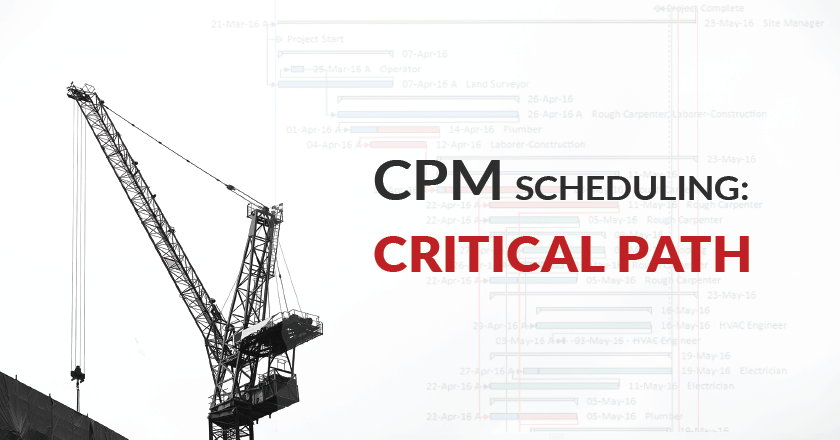What is CPM Scheduling?
The CPM scheduling method is one of the most important and widely used techniques when it comes to planning and managing construction & engineering projects with high level of complexity.
A firm grasp of the theory of CPM scheduling will help any scheduler understand and build schedules that accurately reflect the work on the field.
CPM stands for Critical Path Method, which in fact represents a set of instructions or rules for scheduling projects. This methodology allows us to logically paint a graphical picture of the project, or in other words create a project plan, through which we can estimate the time and resources required to complete the project.
By referring to the CPM plan or schedule we can manage events, adhere to the time frame of the planned activities, and control the project execution.
However, to truly understand CPM, one must first understand the meaning of the term Critical Path.
What is the Critical Path?
The critical path is the essence that lies at the core of CPM scheduling.
The Critical Path is the path in the project network comprised of a sequence of activities that must be consecutively completed in order for the project to reach its finish date.
How to find the Critical Path?
In project management theory, calculating the Critical Path is done through the Total Float for each activity in the project.
In short, the Total Float represents the difference between the Late and Early Dates of activities. The chained sequence of activities where the Total Float is 0 (or less than 0), starting from the beginning to the end of the schedule horizontal, is in fact the critical path of a project.
Each activity on the critical path has a predecessor and successor activity, excluding the first and last activity. Therefore, activity on the critical path cannot be started until its predecessor activity is completed. Hence, if a task sitting on the critical path is delayed, the project is put at risk of not being completed on time.
The critical path tells us how long it takes to complete the project. A well-designed CPM schedule can help the project team to proactively manage schedule delays, accurately manage resources and ensure the project is finished no later than the designated Finish Date.
CPM scheduling mainly comes down to building the schedule by properly defining each level of activity on the WBS and assigning the dates to activities. This method uses logic to calculate the activities duration and highlight the Project Finish date, which in title allows us to visually identify and manage the critical flow of activities that ensures the timely completion of the project.
Critical Path vs Critical Chain?
The Critical Chain method of scheduling is a relatively new technique related to CPM, which has been designed to overcome some of the drawbacks of the critical path method of scheduling.
The critical chain optimizes the completion of the activities that lie on the critical path based on resource availability. It allows schedulers to be able to create more vigorous schedules with resource-constraint critical paths, which helps them to proactively manage the project flow, resources, and activities.
CCM applies a new approach to managing project progress, by working with the concepts of Buffers as opposed to Float, which increases the probabilities of completing a project on time.
However, the Critical Path Methodology is still the more widely accepted approach to scheduling, especially on projects in industries such as Construction & Engineering.
Tracking the Critical Path with ScheduleReader
With projects becoming increasingly complex and schedules contain thousands of activities, we are faced with difficulties when needed to look up a specific activity, see its start date and analyze its relationship and how it affects other activities in the schedule.
Such cases are most common to the construction industry, where software solutions such as Oracle’s Primavera P6 use CPM to schedule work activities that are considered an industry standard.
Navigating through activities within these types of schedules can be extremely challenging, which is why software solutions such as ScheduleReader exist.
ScheduleReader at its core is a tool that is used to view the data inside XER and XML schedules. The application does not connect to any databases and therefore it opens extremely large project files containing even thousands of activities in a matter of seconds.
Following are 5 ways in which the software can be used to visualize the critical path of a project:
1. View Critical Activities on a Gantt chart
ScheduleReader visualizes the critical activities with red color on its right side Gantt Chart by default. The colors on the Gantt Chart are customizable and they vary depending on the current layout which is used to view the project file.
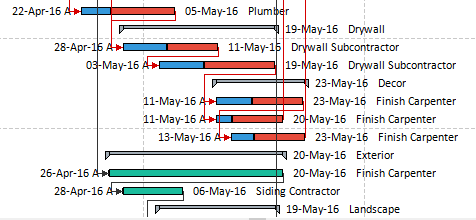
2. Trace Logic and Bottom View
By using Trace Logic, a special feature in ScheduleReader available in the Activity View, you can isolate the critical path of a specific activity, and clearly see that activity’s relations with all of its predecessors and successors’ activities. These activities are presented with boxes rounded with the red line and their relationships are colored in red as well.
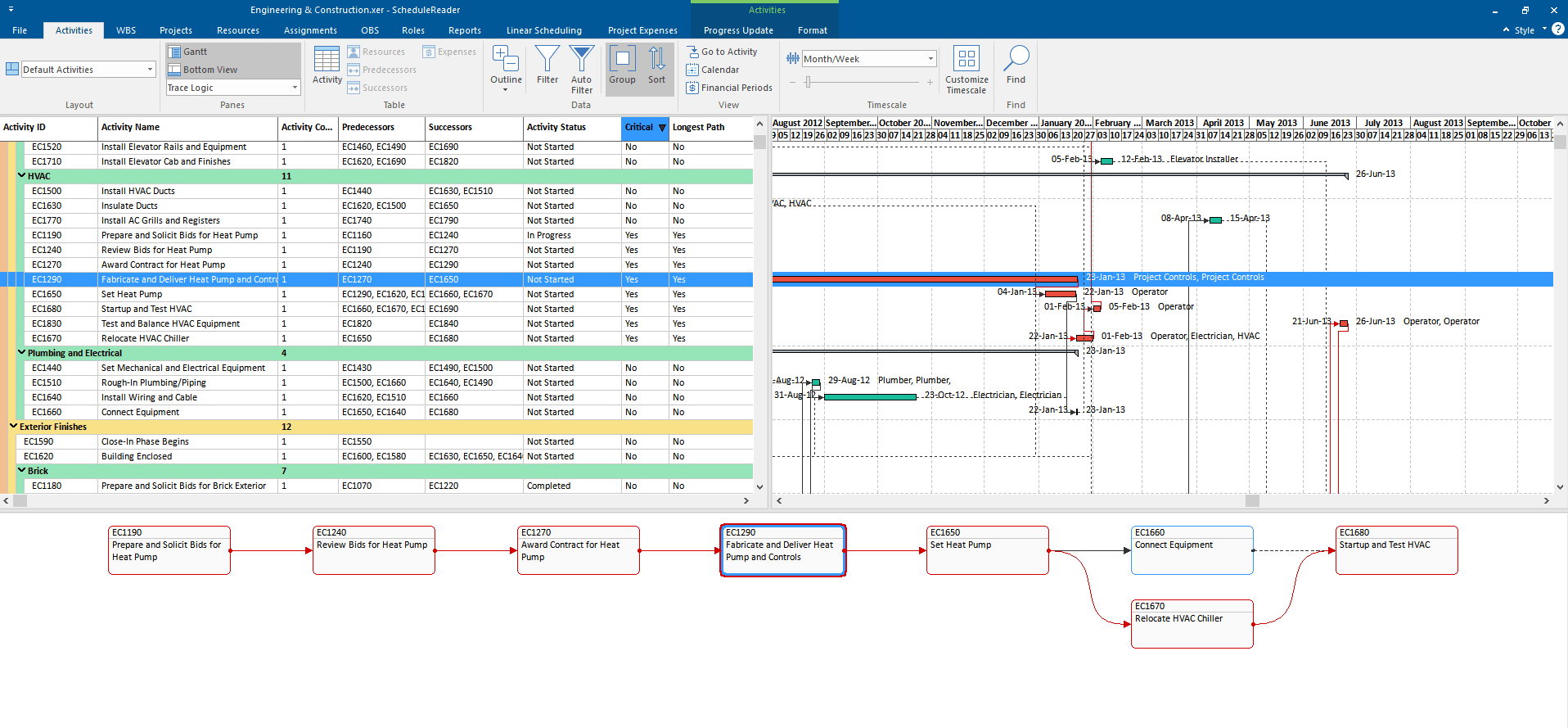
While in the Activity View, the Bottom View in ScheduleReader can also be used for visualizing the Driving Activity relationships.
The term Driving activity is another important concept in scheduling with the Critical Path Method. “Driving Activities” are the activities that determine or have the potential to influence the Start Date of the critical activities from the Critical Path/Critical Chain.
By analyzing the Driving Activities and the Free Float, you can determine the time at your disposal to complete each activity in the schedule without having to postpone the start date of the activities on the critical path. This action ensures that the critical activities start and finish as predicted, and the project gets completed on time, according to the plan.
By selecting the “Details” instead of Trace Logic as the active Bottom View, you can make use of the GoTo buttons from the Relationship tab, to quickly skip to and preview the predecessors or successors to different activities in the schedule.
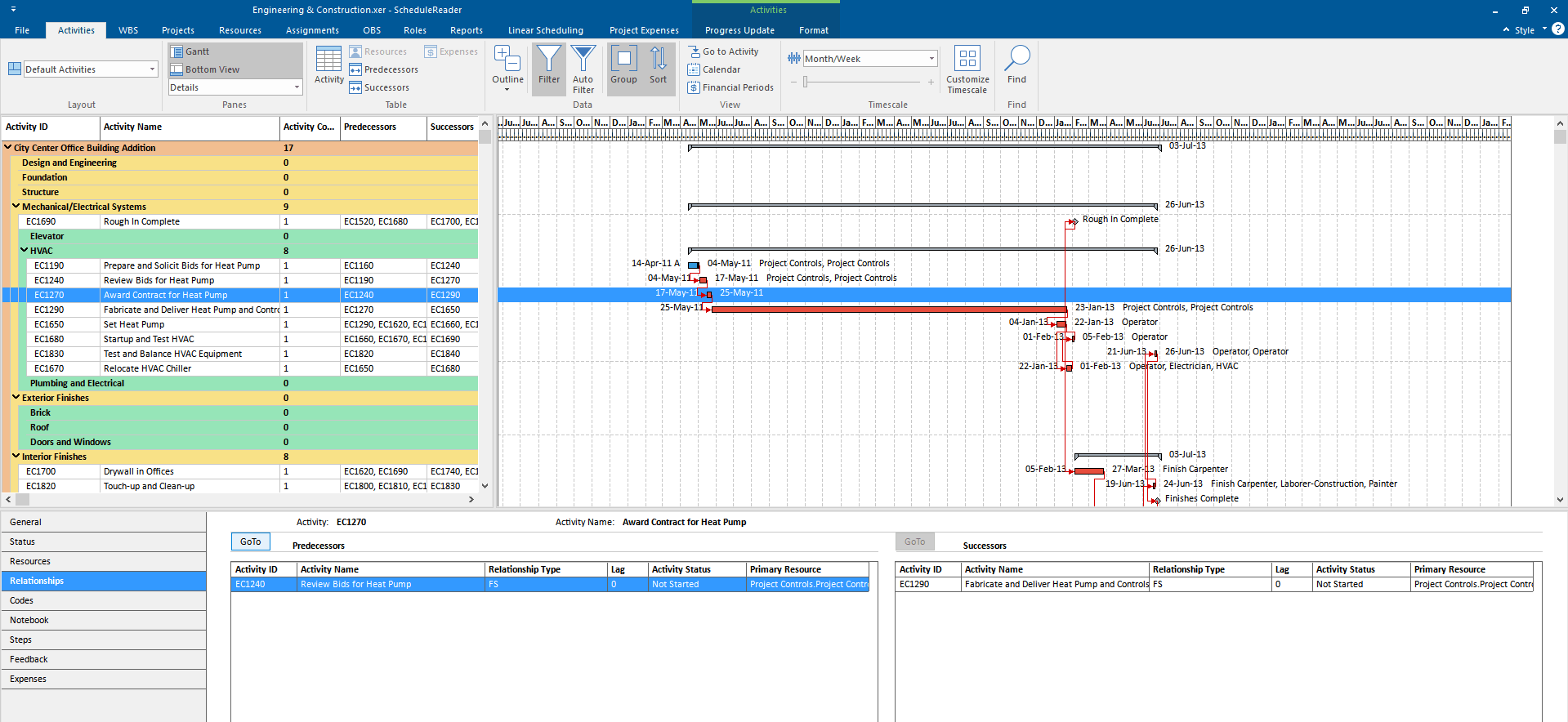
You can easily spot the relations between the driving activities as they are presented with a solid line.

If you are viewing the EPS using the Project View, you can also use the Bottom view to display Schedule Settings for each of the multiple projects in your project plan. Schedule settings provide information about how are the Critical Tasks on the project defined, how is the Total Float calculated, what scheduling logic is used to schedule the project, and more.
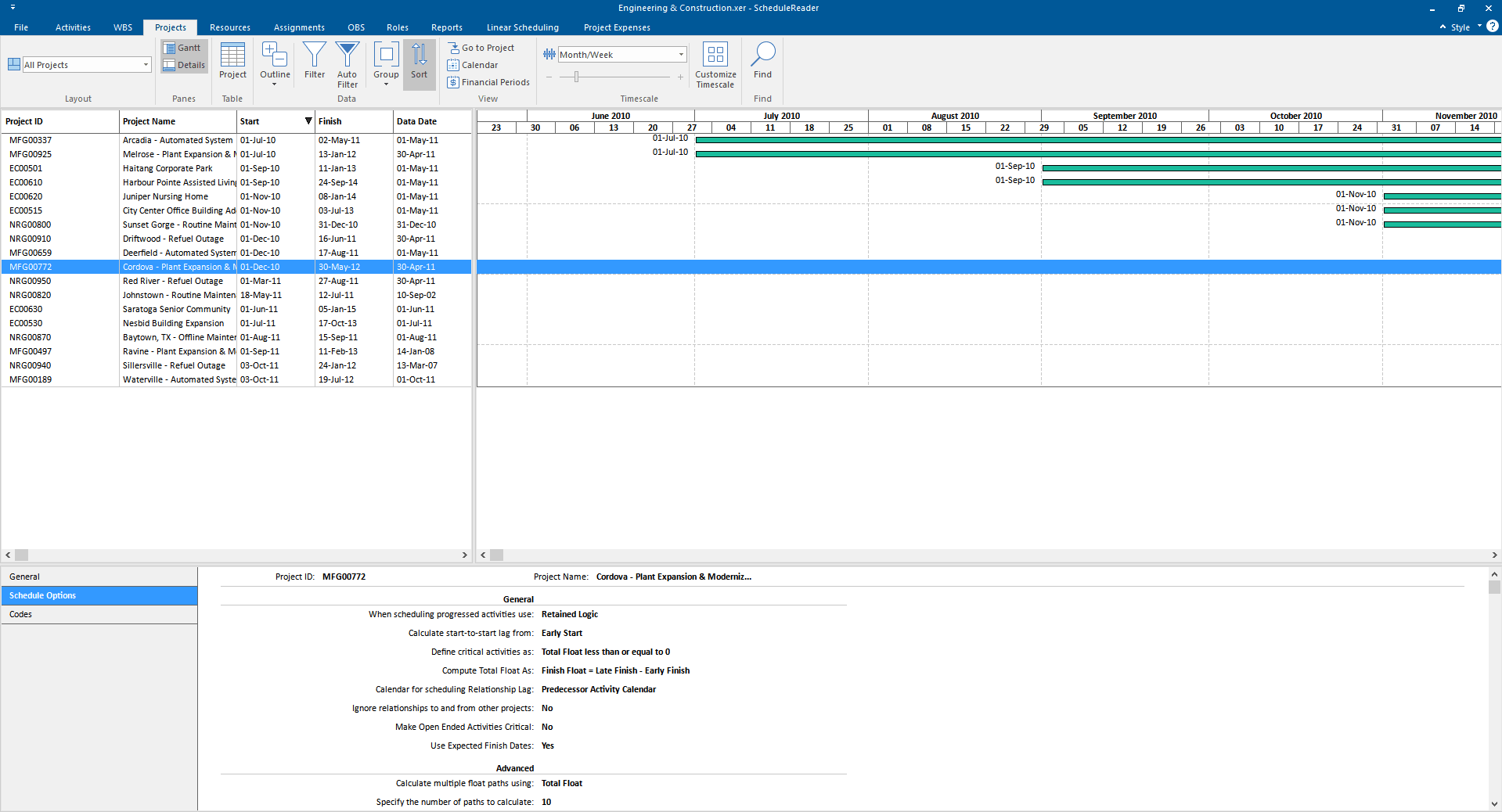
3. The Critical Column in the Activity View
Critical activities can be additionally displayed in the tabular view on the left side of the ScheduleReader interface, by simply adding the Critical column while viewing project data in the Activity View.
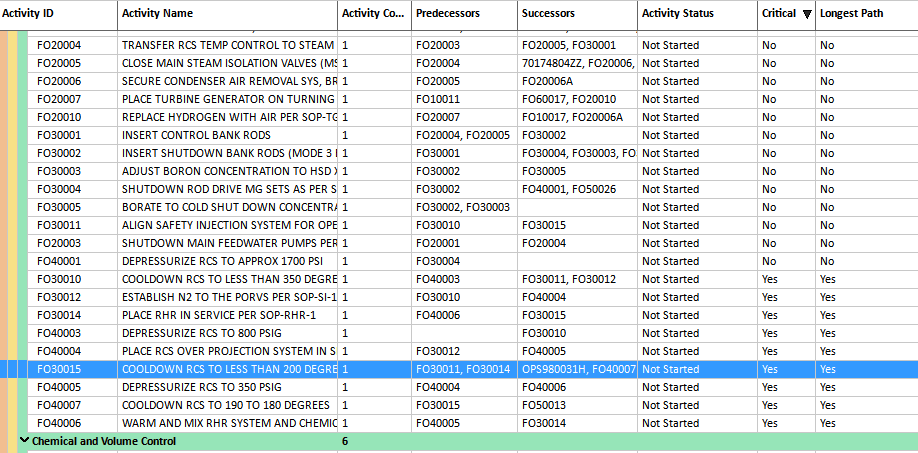
The Critical column consists of two values, “Yes” for the activities that lie on the critical path and “No” for the others.
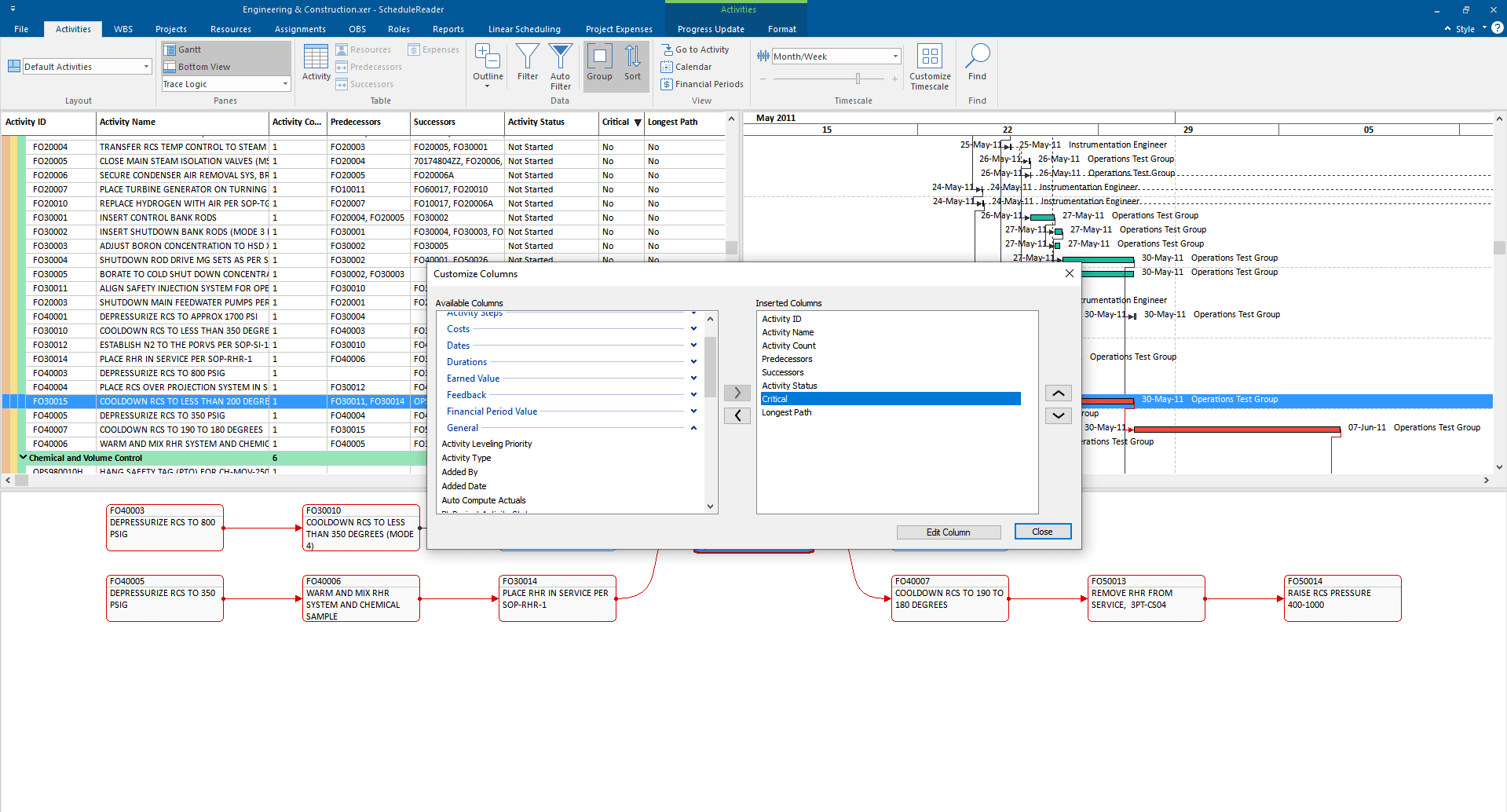
4. Use Filters
A handy feature in SchedulerReader that allows you to show or hide activities by using the Critical filter. This will isolate and display only the activities that lie on the Critical Path of the project, which is very useful if the project contains a large number of activities.
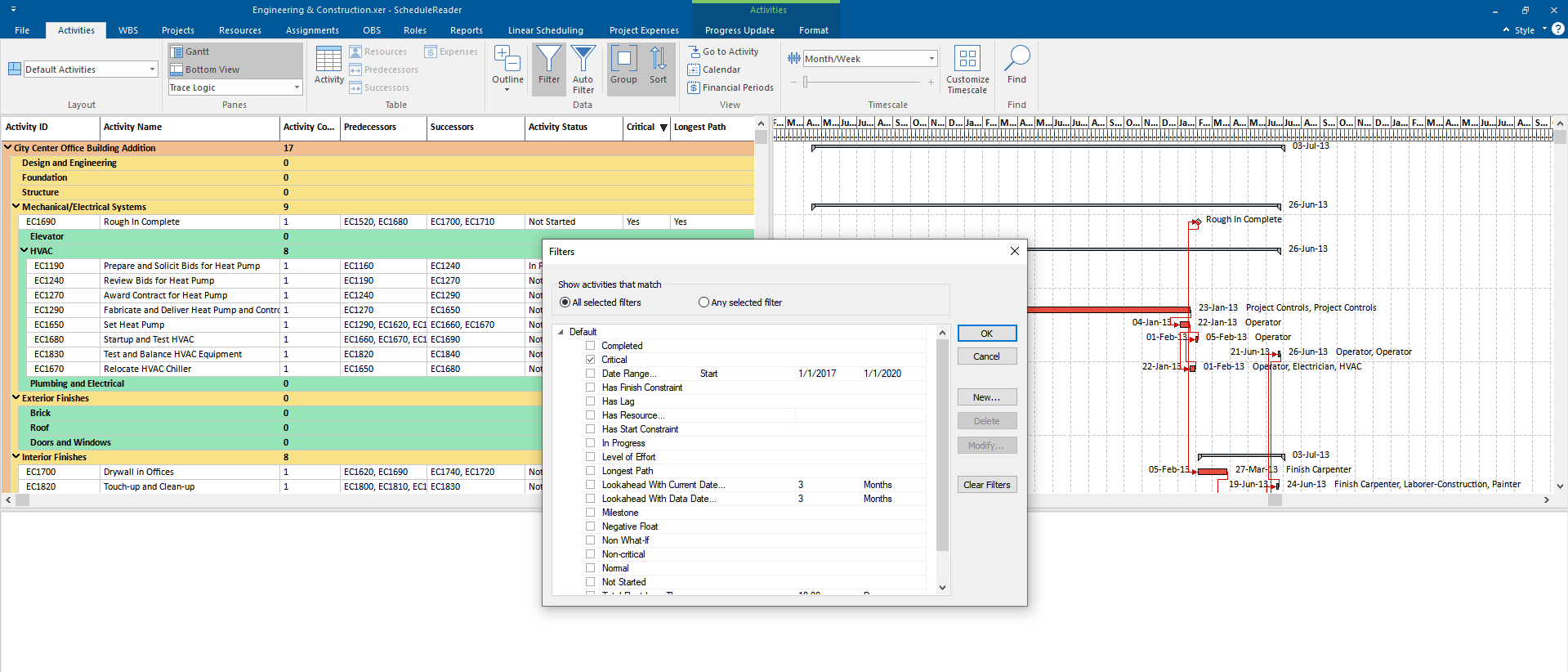
Different predefined filters exist such as a filter for the Longest Path, as well as the ability to create custom ones.
What is the Longest Path?
The Longest path represents the sequence of activities (path) with the highest Total Duration value, or in other words the path with activities that takes the longest time to complete.
Critical Path vs Longest Path. What is the difference?
The Longest Path is a Critical Path, but not all Critical Paths are the Longest. On-time completion of the activities on the Longest Path also results in an on-time finished project.
5. Graphical Reports – Available in the PRO Version
Test the Critical Path Integrity With a DCMA 14 Report
The DCMA 14 report in ScheduleReader can be used to quickly test the logic of the schedule network, including the critical path which is one of the 14 checkpoints of this report.
The DCMA 14 Report can also test your Critical Path Length Index (CPLI) and additionally alert you if you have missing predecessors or successors’ activities, dates, and float logic anomalies.
The report data can even be exported in Excel and shared with schedulers who can go back to review and make changes to the project schedule.
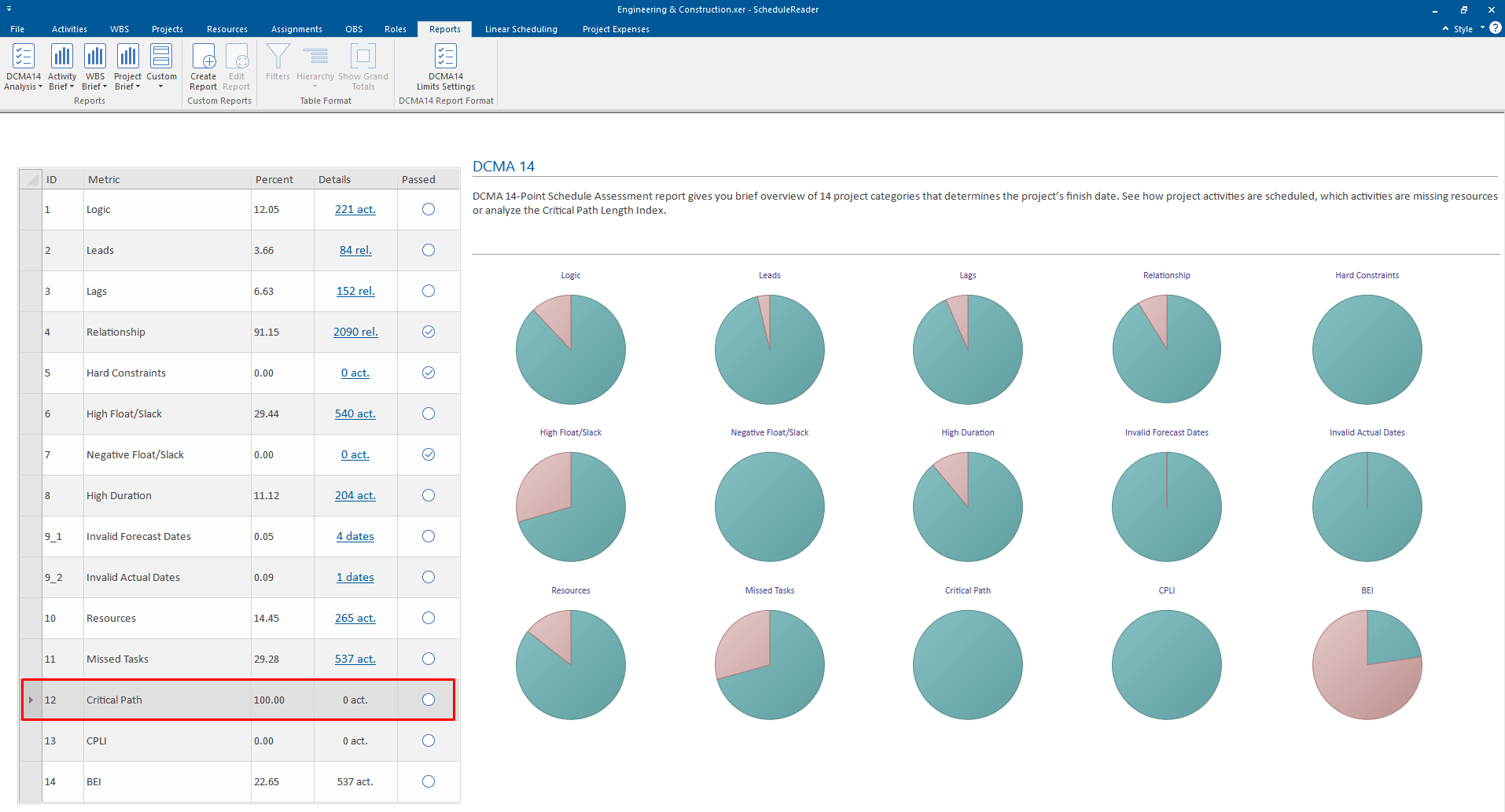
Create a Custom Report with Critical Activities
The custom reports in ScheduleReader PRO allow you to create table and chart-like reports on which you can include different parameters from the project. You can make combinations of both types, in order to compare data side by side or present your summary in a single chart which can take different forms such as bar, column, line.
The dynamic graphical reports in ScheduleReader can be used to create a critical path report.
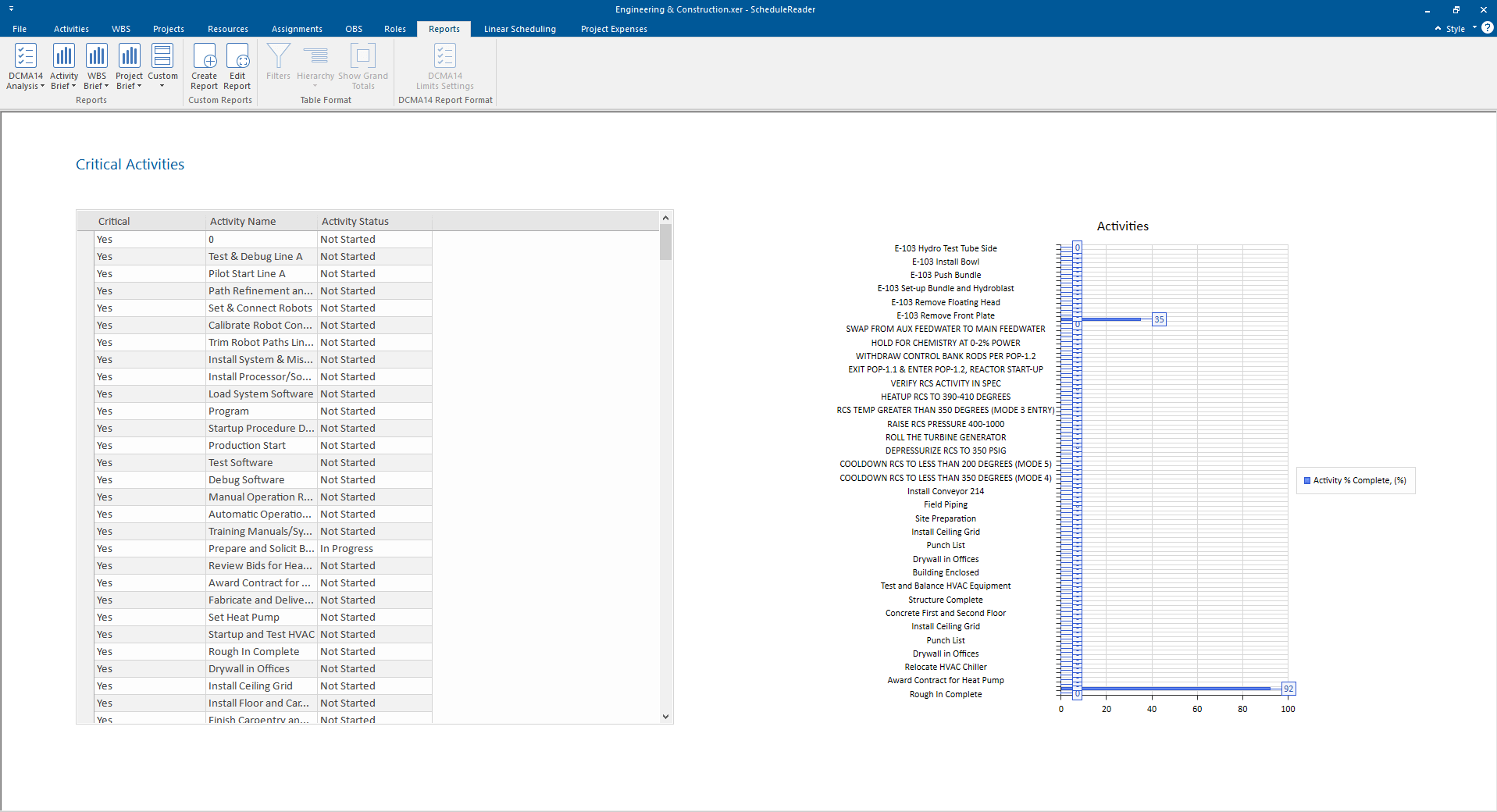
The reports are saved on the application level, which means you can access them at any time and re-apply them to different projects imported in the Reader. You can also export them and further distribute them to other project stakeholders who can import and view them in their ScheduleReader.
Use the Critical Activity Filter in the Activity Reports
The PRO version of ScheduleReader also features predefined Activity Reports, where you can apply the Critical filter and get different data (activity status, activity units and activity steps information) with a focus on the selected critical activities.
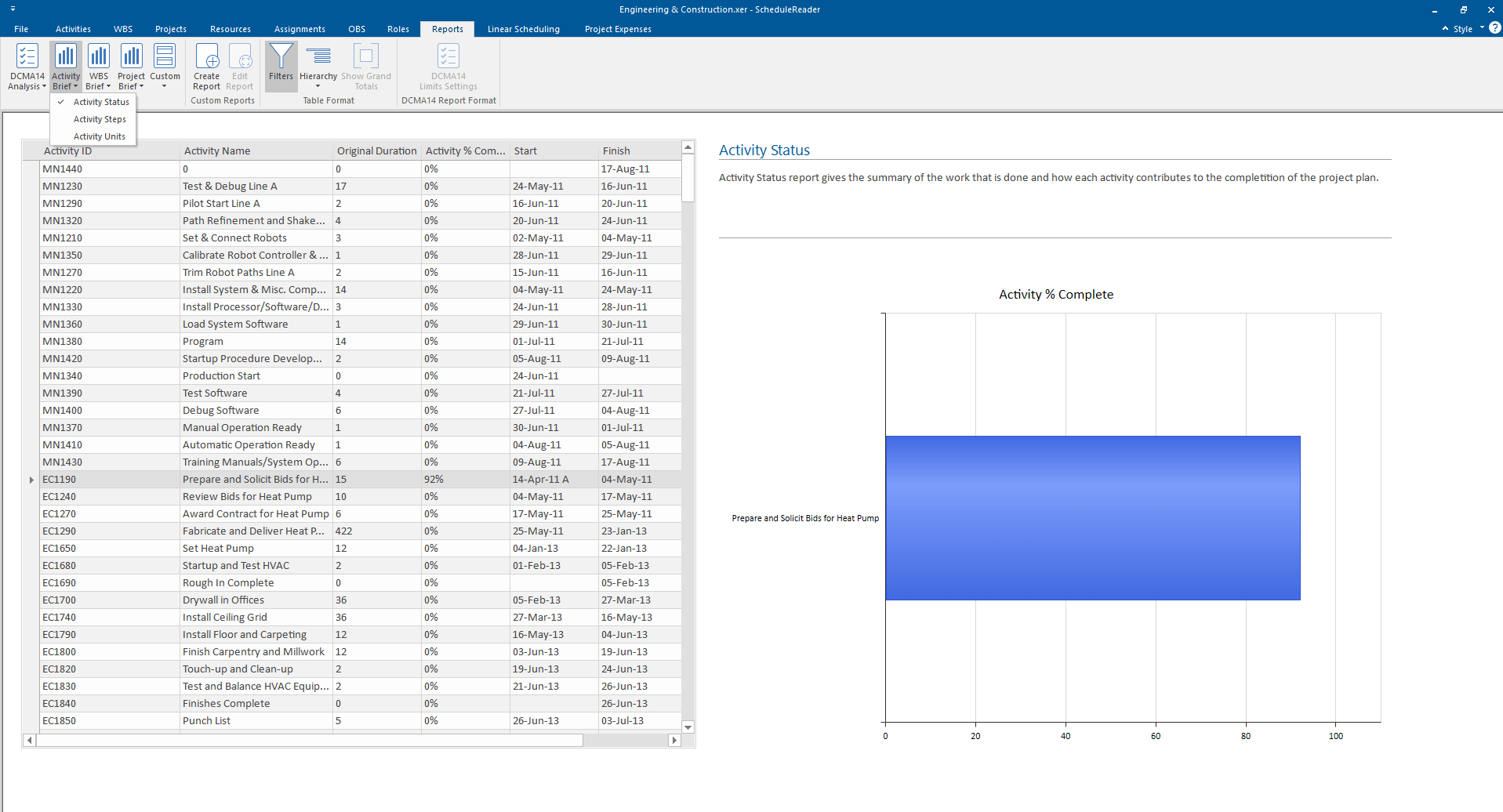
The Importance of Critical Path Management in CPM Scheduling
CPM scheduling makes it possible to logically calculate the project duration and keep everyone focused on their tasks during the project execution. It brings clarity and helps project teams to better understand the project before it starts and maintain greater control of events after.
At the core of CPM Scheduling lies the critical path, which is essential to keep track of in order to successfully manage the project, and ScheduleReader is the perfect utility tool that anyone can use to quickly visualize the critical path projects in the XER and XML file format.
Visualizing the critical path allows tasks to be prioritized and managed on time. This is what essentially helps keep projects on schedule.
Construction Project Managers
By visualizing the layout of the work in phases with ScheduleReader, construction project managers can keep periodic control and timely engage and coordinate with other contractors and sub-contractors in the project.
By tracking the project’s critical path they can get a clear understanding of which steps to take to put late projects back on track and avoid project delays. PMs can use look-ahead filters in combination with critical and other filters to create different schedule views and manage activities while relying on the Critical Path Methodology to bring business decisions as the project progresses.
Schedulers
The Critical Path Method of scheduling allows schedulers to create structured, logical schedules and set objectives for everyone to follow in order to for the project to be completed successfully.
It is considered efficient scheduling because it separates critical activities, the ones that cannot be postponed, from activities that can be performed in parallel, and provides a clear picture of the project time frame, and every participant’s role at each stage of the project.
CPM also helps schedulers to access the impact of different events affecting the project and incorporate changes to project structure by following a standard set of logic.
Project Controls
Visualizing the critical path allows greater control over risks and uncertainty. It allows project controls professionals to better control project progress, costs and timely avoid any potential project delays. Project controls can also refer to CPM scheduling to evaluate the project progress, the teams, and subcontractor performance.
In the events of a dispute, CPM schedules can even play an important role in assisting consultants in arbitration processes, where they need to demonstrate how a project was executed and what was critical at the time.
Analysis of the critical path can also help project owners in defining change orders, granting time extensions, and more.
About the Author:
Vivien Goldstrong is a Consultant, Author, and Planning Manager with 22 years of experience and expertise in implementation and consultancy related to Oracle® Primavera P6.

